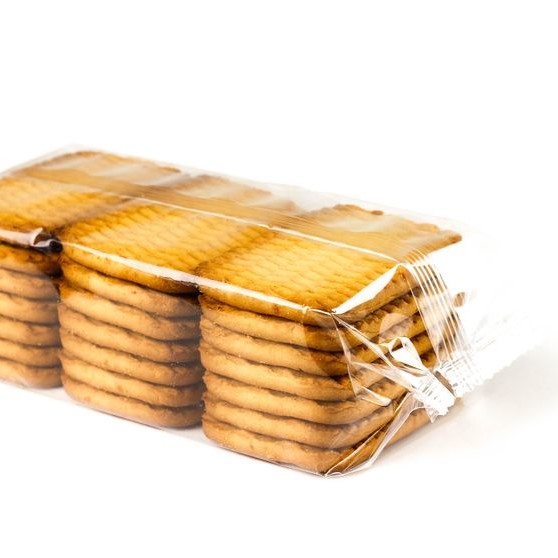
Packaging
What is Packaging?
Packaging is a combination of technological processes to enclose and protect finished food products to preserve and transport them. The main purpose is to maintain the integrity and sensorial properties of the food by protecting it from microbiological spoilage and staling.1 Failure to recognize its importance can have a negative impact on consumer acceptability.
Proper packaging is expected to perform in three different environments:
- Physical: physical damage due to drops, shocks, falls and bumps
- Ambient: damage due to parameters of the surroundings environment (ex. gases,water, light)
- Human: interaction with the consumer
How does it work?1
The main function is:1
- Containment: enclosure of food product
- Protection: against microorganism, water exchange, odors, dust and compressive forces
- Convenience: by offering the consumer comfort during usage and allowing for easy application of secondary, tertiary and quaternary packaging
- Communication: promote the product and inform consumers about its characteristics
Food products are typically packed in four stages:
- Primary packaging: direct contact with the food product, it is the initial protective barrier, (ex. plastic pouches, paperboard cartons)
- Secondary packaging: physical distribution package, may be used in the display of the product (ex. boxes)
- Tertiary packaging: made up of several secondary packages (stretch-wrapped pallet of corrugated boxes)
- Quaternary packaging: made up of several tertiary packages for international trade (ex. metal containers)
Types of packaging1
A variety of techniques can be used for baked goods:
- Simple plastic packaging: typically consists of a low density polyethylene (LDPE), oriented polypropylene (OPP) or polyethylene terephthalate (PET).
- Vacuum packaging: removal of air from the packaging before closing, suitable only for pita bread and pizza bases.
- Modified Atmosphere Packaging (MAP): substitution of oxygen content in packaging with an inert gas or combination of gases such as carbon dioxide (CO2) and nitrogen (N2).
Parameters1
Maintaining adequate quality in packaged foods requires serious consideration to many parameters mainly:
- Temperature: may enhance or reduce microbial growth.
- Relative humidity: driving force of moisture exchange between the product and the surrounding environment.
- Packaging material: the properties of the material like oxygen permeability can affect the stability of baked goods.
- Nature of baked goods: the water content and water activity affect microbial growth, taste and other sensory properties. Some baked goods are more prone to certain microbial growth than others. Fat content can cause rancidity development.
Equipment2
Essential packaging equipment required in food and baking production plants includes:
- Wrapping equipment: a length of the wrapping material is used to form a tube around the product prior to separation
- Bagging equipment: bags are blown open with air and the product is introduced. Later, the bags are sealed with a tag or heat sealed.
- Vertical form-fill sealed equipment: used in dump packaging of cookies
- Equipment for registered packaging of cookies: cookies are packaged together as one unit
Failures of proper packaging1
- Microbial spoilage: microbial growth mainly mold
- Staling: decrease of consumer acceptance
- Moisture loss or gain: water exchange between crumb, crust and the surrounding atmosphere affects bread quality
- Rancidity: development of off flavors and odors due to fat oxidation
- Fat bloom: surface discoloration of chocolate- and fat-containing cookies
Application1,2
Baked goods can be packed in a variety of forms depending on product type. For example, pita bread and pizza bases can be vacuum sealed, while regular bread requires techniques and materials that preserve loaf volume.
The table below highlights options for several baked goods:
| Baked Good | Type of Packaging | Benefits | Drawbacks |
| Biscuit, crackers and cookies | RCF* coated with LDPE or OPP film | Flavor and aroma barrier | Requires a heat seal to improve sealability. |
| Bread | Plastic bag, typically a LDPE bag sealed with a twisted tag | Retards moisture loss. | Moisture migration from crumb to crust generating a leathery crust. |
| Tortilla, bagels | Modified atmosphere | Considerably extends shelf life. | Relatively expensive |
| Pita bread and pizza base | Vacuum sealed | Prevents mold growth and retards oxidation. | Relatively expensive. May damage product volume. |
| Speciality bread | Plastic bag, typically an OPP or PET bag with perforations. | Retains crisp crust | May pose contamination risk due to film perforations. |
*RCF: regenerated cellulose film
Other packaging alternatives include ethanol (95% v/v) or antimicrobials surface spray prior to packaging, or the addition of oxygen absorbers to reduce oxygen level side the package.
References
- Robertson, G. L. Food packaging: principles and practice. 3 rd ed., CRC press, 2016.
- Sumnu, S. G and Sahin, S . Food engineering aspects of baking sweet goods. 1 st., CRC Press, 2008.
[/fusion_text][/fusion_builder_column][/fusion_builder_row][/fusion_builder_container]

